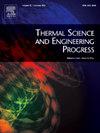A review of cryogenic carbon capture research: Experimental studies, simulations, and application potential
IF 5.1
3区 工程技术
Q2 ENERGY & FUELS
引用次数: 0
Abstract
The growing global population has increased energy demand, primarily met by non-renewable sources, leading to higher greenhouse gas (GHG) emissions and accelerating climate change. Cryogenic carbon capture (CCC) offers a promising solution by extracting CO2 from gas streams, cooling it into liquid or solid states, and reducing the reliance on harmful chemical solvents. This study reviews recent advancements in CCC, focusing on experimental research, simulations, and the technology readiness of CCC methods. The growing interest in CCC is fueled by technological progress and rising climate awareness. Modern methods, such as packed bed systems, external cooling loops, and CryoCell technology, can capture over 99% of CO2, primarily using liquid cryogenic methods like liquid nitrogen. This approach enhances cooling efficiency and can be integrated with systems like heat exchangers to improve performance. Despite its promise, CCC remains in the research phase, with most applications at small-scale levels and simulations. Aspen Plus is the primary tool for modeling. Future research should focus on improving efficiency, integrating renewable energy sources, and exploring hybrid systems that combine CCC with other techniques like adsorption and absorption. Additionally, converting captured CO2 into valuable products, such as synthetic fuels and chemicals, could provide economic incentives. Addressing these challenges would allow CCC to significantly reduce industrial CO2 emissions and support global climate action goals.

低温碳捕获研究综述:实验研究、模拟和应用潜力
本文章由计算机程序翻译,如有差异,请以英文原文为准。
求助全文
约1分钟内获得全文
求助全文
来源期刊

Thermal Science and Engineering Progress
Chemical Engineering-Fluid Flow and Transfer Processes
CiteScore
7.20
自引率
10.40%
发文量
327
审稿时长
41 days
期刊介绍:
Thermal Science and Engineering Progress (TSEP) publishes original, high-quality research articles that span activities ranging from fundamental scientific research and discussion of the more controversial thermodynamic theories, to developments in thermal engineering that are in many instances examples of the way scientists and engineers are addressing the challenges facing a growing population – smart cities and global warming – maximising thermodynamic efficiencies and minimising all heat losses. It is intended that these will be of current relevance and interest to industry, academia and other practitioners. It is evident that many specialised journals in thermal and, to some extent, in fluid disciplines tend to focus on topics that can be classified as fundamental in nature, or are ‘applied’ and near-market. Thermal Science and Engineering Progress will bridge the gap between these two areas, allowing authors to make an easy choice, should they or a journal editor feel that their papers are ‘out of scope’ when considering other journals. The range of topics covered by Thermal Science and Engineering Progress addresses the rapid rate of development being made in thermal transfer processes as they affect traditional fields, and important growth in the topical research areas of aerospace, thermal biological and medical systems, electronics and nano-technologies, renewable energy systems, food production (including agriculture), and the need to minimise man-made thermal impacts on climate change. Review articles on appropriate topics for TSEP are encouraged, although until TSEP is fully established, these will be limited in number. Before submitting such articles, please contact one of the Editors, or a member of the Editorial Advisory Board with an outline of your proposal and your expertise in the area of your review.
 求助内容:
求助内容: 应助结果提醒方式:
应助结果提醒方式:


